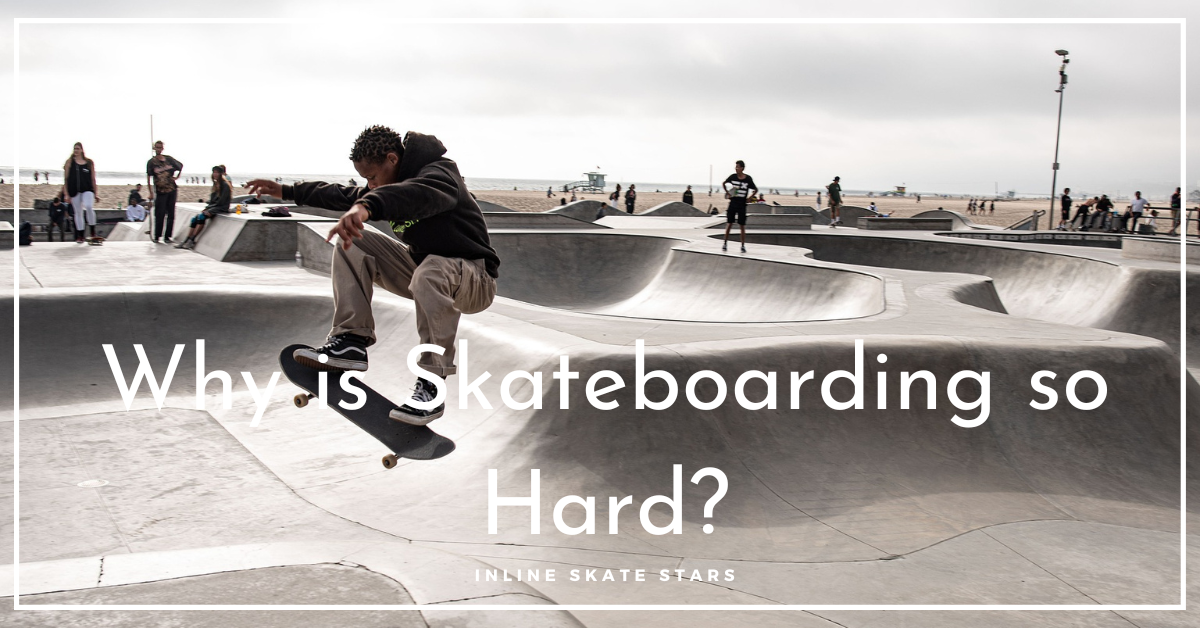Are you a skateboarding enthusiast? You know how tough skateboarding is. It is not a sport to learn for one day and become an expert.
You must acquire skating skills, master them, and implement them. Learning skateboarding takes time, so attention and commitment must be your guiding qualities.
Why is Skateboarding so Hard?
Why is skateboarding so hard? Skateboarding is so hard because it requires body coordination, body balance, and strength. The training process is also tiresome.
1. Skateboarding Requires Body Coordination
First, controlling the whole body is a hassle, from the upper body to the lower body part.
Body coordination calls for your full attention. It can take more than a month to learn simple coordination.
Coordination, pushing, and mastering skateboard movement all work together.
It is also hard to learn pushing skills and skateboard movement. Your body must be flexible to move the board.
But, sports lovers find it simple to learn tricks, especially athletes.
Practice more; let every day count to your training. Moreover, visit skate parks as well for more practice.
The tricks are hard to learn, but you can’t be a newbie forever. The most successful skaters dedicated their time to learning and implementing.
You might be surprised when you become one of the best skaters.
2. Skateboarding Requires Strength
Your strength is essential when skateboarding. You need the energy to move from one place to another.
First, you must lift your body and jump to land on the board. Some people’s weight cannot allow their bodies to jump and stabilize on a skateboard.
Even so, other people with less weight struggle with body stability. So, lifting your body depends on your flexibility.
3. Skateboarding Requires Body Balance
Mastering balancing skills is tough when learning skateboarding. However, some strategies should guide your to achieve balancing skills. But it takes patience and consistency.
The following steps help to balance your body;
- Know where to place your feet on the board. You can either use a goofy or regular stance. Regular position means you are facing on the right side or your left leg is facing forward. The goofy means you face on your left with your right foot forward.
- Put your front foot and the back foot behind bolts. Feet placed behind the bolts enhance body balance. You can break your board if your place your feet in the middle. When your feet are behind the bolts, it gives you control of the board. The board wheel depends on the bolts for survival. If you damage the bolts, the wheel will be faulty, and the board cannot move.
- Stand on board when it cannot roll, for instance, on grass. Try to balance your board when on stable ground. You might not master balance well when the board is in motion.
- Balancing is not easy at first, but you can learn while standing on the grass to avoid turning.
- Support your wheel to stop unnecessary movements. Use an object like a plank of wood to support both sides.
- Hold a wall for support. If you can’t balance yourself while the board is stable, try to hold on to a wall or any object to support your balance.
- Also, ask a friend to help you balance yourself. When you hold your friend, the wheels should be moving. That way, you will learn confidently with someone controlling your balance.
4. Tiresome Training Process
In comparison to roller skating, the skateboarding training process is hard and can take months to learn ollie tricks.
It is advisable to train in a safe environment where you cannot be injured when you fall. You can do that at home or on the carpeted ground.
If you know the balancing trick, the training process becomes simple.
Sometimes you might get injuries that need special attention. The skateboarding training process stops until you fully recover.
Mastering the trick over and over is also tiresome.
Your trainer should teach you all the skateboarding tricks, or you practice them alone.
You have your board to learn the pushing technique. Learning energy application on one leg, how to lift the other one, and push forward is tedious.
Compare>> Rollerblading Vs. Skateboarding | the Ultimate Comparison
5. Elongated Implementation process
The skills learned must be implemented. But, the process is long and hard.
Gather your confidence to stand on the board. Avoid the fear to fall down and stand on the board, balancing yourself well.
Push off your board. The trick comes after knowing the balancing technique.
If you are a beginner, you can only take small stabs until you get used to the long ones.
Finally, start moving in your preferred direction. Now that you are in motion, you should take the riding position.


